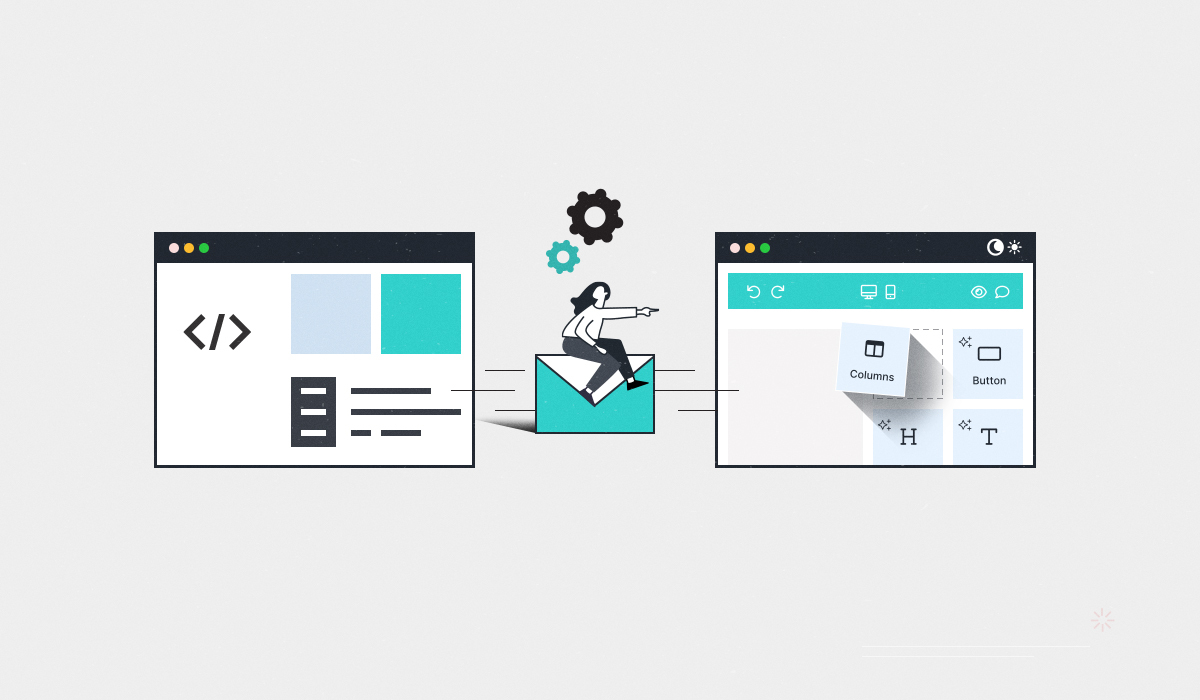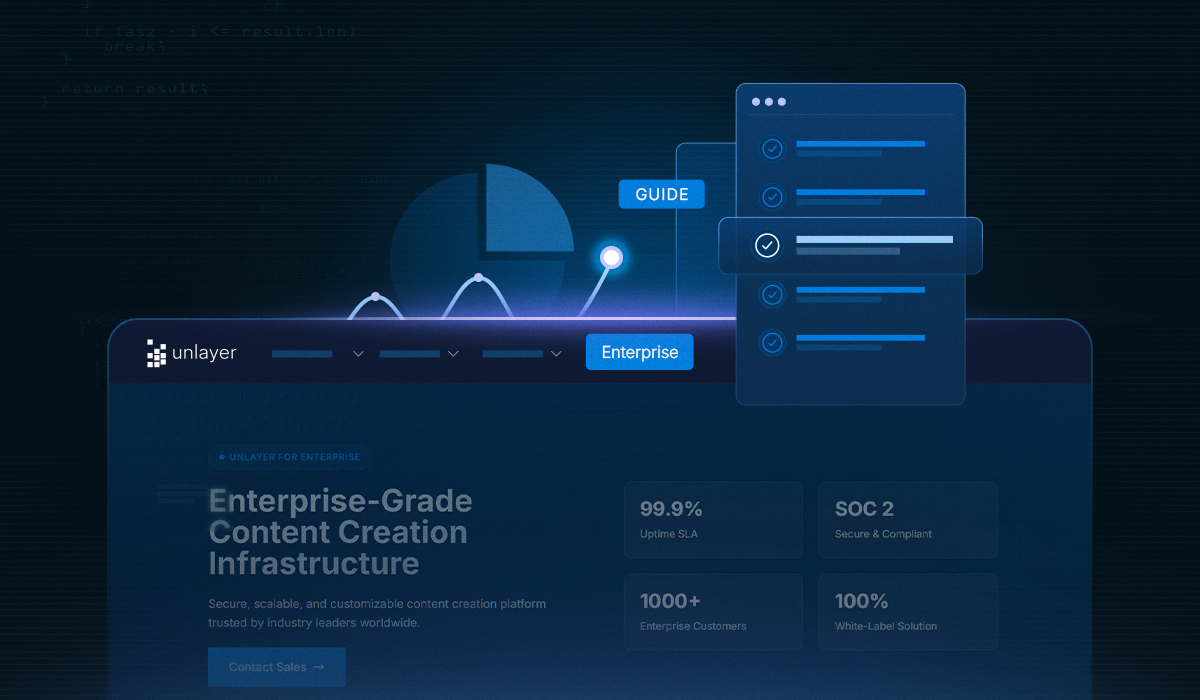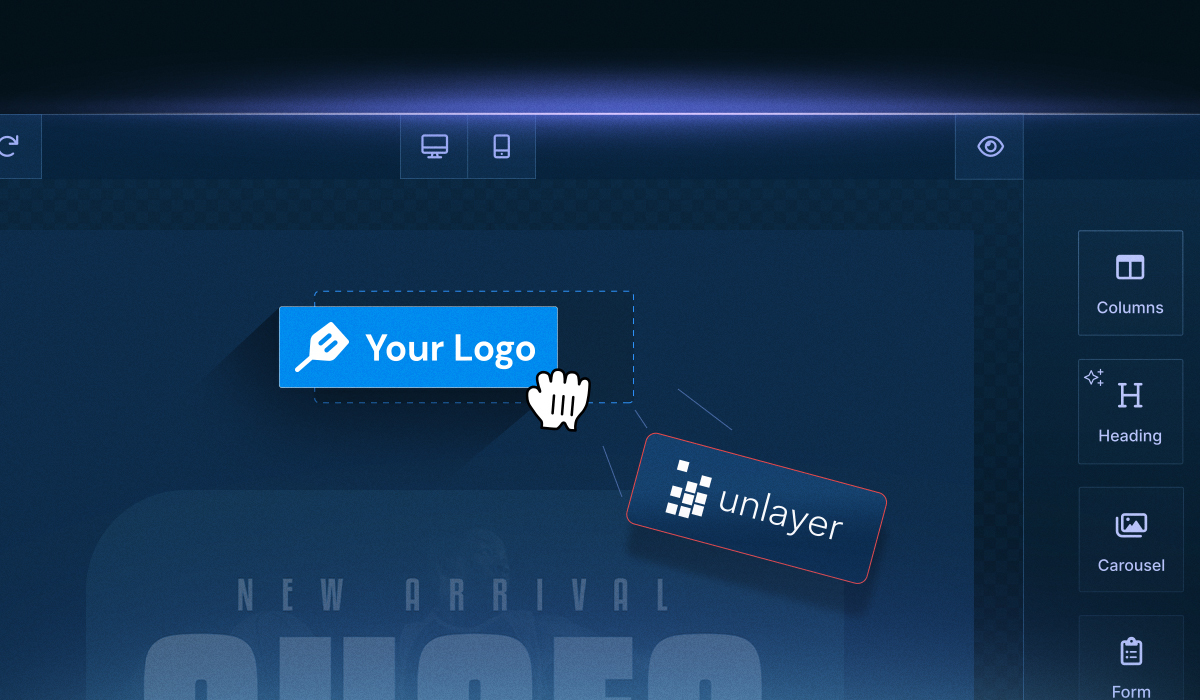Developers today need to build fast, without losing flexibility. That’s why the debate between low‑code vs. embedded builder SDKs is so timely.
On one end, low‑code platforms promise rapid development with minimal code. On the other hand, embedded SDKs offer white‑label editors you can embed in your host app in minutes. All while keeping complete control over customization and scalability.
In the early days of development tooling, teams were forced to choose: go full low‑code for speed, or build everything from scratch for flexibility.
Modern embedded builder SDKs blur those lines. They let developers drop in a drag‑and‑drop editor, fully styled and API‑driven, without sacrificing performance or branding.
To see how SDKs and APIs work together, check out our guide on embeddable builder SDKs and API integration.
In this post, we’ll break down what sets low-code platforms and embedded builder SDKs apart, focusing on developer experience, setup speed, customization, performance, and scalability.
We’ll also spotlight Unlayer, an SDK you can embed in React, Angular, Vue, or plain JavaScript apps with minimal setup.
Let’s begin!
🧩 What Is a Low-Code Platform?
A low-code platform lets teams build applications using drag-and-drop interfaces, reusable components, and minimal hand-coding.
Popular platforms like OutSystems, Mendix, and Retool are often used to spin up internal dashboards, CRMs, or even customer-facing tools with impressive speed.
In the context of email builders, landing page editors, popups, or document generators, low-code solutions offer prebuilt modules that help teams get a product to market faster, especially for internal marketing tools, sales enablement platforms, or custom CRMs.
⚙️ Typical use cases include
Marketing teams creating branded emails without developer support
Sales platforms offering drag-and-drop email, document, or landing page builders
Internal CRMs embedding email, form, and landing page builders for lead-gen
No-code admin panels to generate documents or email templates
✅ Pros of low-code platforms
Fast prototyping for internal tools or MVPs
Reduces engineering overhead for non-core UI components
Business users can manage content without dev involvement
⚠️ Cons of low-code platforms
Vendor lock-in limits customization and migration flexibility
Design consistency may suffer across user experiences
Developers have less control over performance and fine-tuning
Difficult to scale or embed in public-facing apps with high branding demands
For platforms that require embedded, on-brand builders inside the product, especially in the SaaS or CRM space; low-code can be helpful in early stages.
But when full control over UI, logic, scalability, and extensibility becomes critical, you might hit limitations quickly.
🔧 What Is an Embedded Builder SDK?
An embedded builder SDK is a plug-and-play development kit that integrates directly into your existing app or platform, giving you full control over the UI, data flow, and user experience.
Tools like Unlayer make it easy to drop in fully functional builders for emails, landing pages, popups, and documents, all within your own branded environment.
Unlike low-code platforms, embedded SDKs don't require you to send users to a third-party interface. You own the entire experience, from how the editor looks to how it saves, exports, or interacts with your backend.
⚙️ Typical use cases include
Embedding an email editor inside your CRM or marketing platform
Adding a landing page builder to a website builder or CMS
Offering a popup editor in a product growth or onboarding tool
Letting users create branded documents in a sales or HR platform
✅ Pros of embedded builder SDK
Full control over UI/UX, logic, and design system
Seamless integration with your tech stack and data workflows
Highly scalable, with the flexibility to customize or extend
Developer-friendly, with clear APIs, callbacks, and events
⚠️ Cons of embedded builder SDK
Requires dev resources for setup and integration (though setup is typically fast)
Note: If you're building a product where the editor is part of the core experience and needs to look and behave like the rest of your app, an embedded builder SDK is the developer’s tool of choice.
Side-by-Side Comparison: Low-Code vs. Embedded Builder SDK
Feature | Low-Code Platform | Embedded Builder SDK |
Setup Speed | ✅ Very fast to prototype and launch | ✅ Requires dev setup (but usually quick and is within minutes) |
Customization | ❌ Limited to what the platform allows | ✅ Full control over UI, logic, and branding |
Scalability | ⚠️ May hit platform or vendor limitations | ✅ Scales with your product architecture |
Dev Experience | ❌ Abstracted; less flexible for engineers | ✅ Built for developers with clean APIs |
Integration | ❌ External platform or hosted interface | ✅ Embedded natively in your own application |
Performance | ⚠️ Platform-dependent and less tunable | ✅ Tuned to your app's performance needs |
👨💻 What Developers Actually Prefer
When it comes to choosing between low-code platforms and embedded SDKs, developers overwhelmingly lean toward tools that offer flexibility, transparency, and control.
Low-code platforms may be helpful in the early stages, but they often create friction down the line, specifically when teams need to customize the UI deeply, handle specific edge cases, or maintain performance at scale.
For developers, abstracted logic and rigid templates simply don’t cut it.
By contrast, embedded builder SDKs give developers exactly what they need:
Custom theming to match app branding
Extensibility via APIs, callbacks, and modular components
Seamless scaling as apps grow in complexity
That’s why embedded SDKs are the go-to choice for modern SaaS platforms, CRMs, marketing tools, and other productized experiences where the builder is a key part of the UX, not just a bolt-on.
🚀 Why Developers Choose Unlayer: An Embedded Builder SDK
Unlayer is a developer-first, plug-and-play SDK that enables you to embed powerful builders for emails, landing pages, popups, and documents with minimal effort.

Quick overview of Unlayer
Embeds smoothly into your frontend with just a few lines of code
Supports multiple builder types: email, landing page, popup, document with one unified SDK
Setup is quick and well-documented, perfect for fast iteration in dev-heavy environments
🔗 Helpful resources:
Highlights of Unlayer SDK
Drag‑and‑drop, white‑label builder: Fully customizable editor you can brand and theme to match your app’s look and feel
API‑first architecture: Includes clean callbacks, event listeners, export functions, and support for custom blocks and tools, giving developers actionable control over functionality
Fast setup based on clear docs: Integration typically takes just a few lines of code, e.g., adding the script tag or installing the React/Vue/Angular component and initializing the editor
Scalable and enterprise secure: Provides SOC 2 compliance, domain whitelisting, version locking, 99.9% uptime, and enterprise support, making it ideal for production-grade apps
👉 Start building with Unlayer today
Sign up for free and embed your first builder in minutes.
Real‑World Testimonial

Read More: How Hive Closed 40% More Leads With Unlayer
🔄 When to Choose What? Low-Code vs. Embedded Builder SDK
Both low-code platforms and embedded builder SDKs serve meaningful roles. But they solve different problems.
The right choice depends on your team’s capabilities, your product’s lifecycle, and how important customization, scalability, and integration are to your success.
✅ Choose low-code if:
You need to launch quickly with minimal engineering input:
Low-code platforms are ideal for building MVPs, admin panels, or internal dashboards where speed matters more than long-term scalability or fine-tuned UX.You have limited developer resources or time constraints:
If your dev team is small or occupied with higher-priority product work, low-code gives non-technical users the power to build functional tools without writing much code.You’re building for internal stakeholders or short-term use:
Tools for internal marketing teams, sales ops, or temporary campaigns can be quickly assembled with low-code platforms and don’t always require deep customization.
✅ Choose an embedded builder SDK if:
You’re building a customer-facing, production-grade platform:
Embedded SDKs like Unlayer are ideal when the editor is a core part of your product, and not an afterthought. They let you own the experience end-to-end, without redirecting users to external tools or compromising on design fidelity.You care about brand consistency, performance, and control:
If you need to style the builder to match your app, manage data precisely, or ensure it scales smoothly across customers and use cases, SDKs offer the control low-code platforms can’t.You want flexibility without being locked into a platform:
Unlike low-code platforms, SDKs let you own the code and the experience, integrate with your own APIs, and extend functionality without hitting vendor limitations.
Final Thoughts
As product teams build increasingly complex experiences, the tooling they choose can either accelerate or constrain their growth. It’s no longer just about what works today, but what can scale, adapt, and integrate with evolving SaaS business needs tomorrow.
For some, low-code platforms serve as a useful launchpad. But for developers building polished, extensible, and user-facing tools, embedded SDKs unlock the flexibility and control that modern apps demand.
In the end, the real question isn’t speed vs. complexity. Instead, it’s about choosing a foundation you can trust.
And when you weigh the trade-offs of low-code vs. embedded builder SDKs, the latter often wins out for teams that want to move fast and stay in control.




